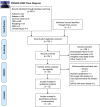Circulating angiopoietin-like proteins in metabolic-associated fatty liver disease: a systematic review and meta-analysis
- PMID: 34034750
- PMCID: PMC8152125
- DOI: 10.1186/s12944-021-01481-1
Circulating angiopoietin-like proteins in metabolic-associated fatty liver disease: a systematic review and meta-analysis
Abstract
Background: Angiopoietin-like proteins (ANGPTLs) are closely related to insulin resistance and lipid metabolism, and may be a key in metabolic syndrome. Non-alcoholic fatty liver disease (NAFLD) (newly named metabolic-associated fatty liver disease (MAFLD)) is based on metabolic dysfunction. There may be some correlation between ANGPTLs and MAFLD, but the specific correlation is unclear. This study aims to explore the predictive role of ANGPTLs in MAFLD and its progression.
Methods: Seven databases (PubMed, EMBASE, Cochrane Library, CNKI, WANFANG, CBM and Clinicaltrials.gov ) were searched with free terms and MeSH terms. The random-effects model was used to pool the data, and Standardized Mean Difference (SMD) and 95% confidence intervals (CI) were taken as the overall outcome. No language restrictions existed in the article selection. RevMan 5.3, Stata 16 and MetaXL software were applied to analyse the data and the GRADE system was utilized to assess the certainty of evidence.
Results: After reviewing 823 related articles, 13 studies (854 cases and 610 controls) met the inclusion criteria, and contributed to this meta-analysis. The results showed that circulating ANGPTL8 level was significantly elevated in the MAFLD group than in the healthy control group (SMD = 0.97 pg/mL, 95%CI: 0.77, 1.18). Conversely, there was no significant difference in the ANGPTL4 (SMD = 0.11 ng/mL, 95%CI: - 0.32, 0.54) and ANGPTL3 (SMD = - 0.95 ng/mL, 95%CI: - 4.38, 2.48) between the two groups. Subgroup analysis showed that: 1) the MAFLD group had significantly higher ANGPTL8 levels than the healthy control group in Asian and other races; 2) the ANGPTL8 levels in Body Mass Index (BMI) > 25 kg/m2 patients with MAFLD were higher than those in the healthy control group; 3) the higher ANGPTL8 levels were observed in moderate to severe MAFLD group than the healthy control group. Meta-regression demonstrated that BMI might effectively explain the high heterogeneity. No significant publication bias existed (P > 0.05). The certainty of evidence was assessed as very low by the GRADE system.
Conclusions: The ANGPTLs may be related to MAFLD. The increased ANGPTL8 level may be positively correlated with different situations of MAFLD, which may act as a potential indicator to monitor the development trends.
Keywords: Angiopoietin-like protein 8; Angiopoietin-like proteins; Meta-analysis; Metabolic-associated fatty liver disease; Non-alcoholic fatty liver disease; Non-alcoholic steatohepatitis.
Conflict of interest statement
The authors declare that they have no competing interests.
Figures













Similar articles
-
Circulating angiopoietin-like protein 8 (ANGPTL8) and steatotic liver disease related to metabolic dysfunction: an updated systematic review and meta-analysis.Front Endocrinol (Lausanne). 2025 Apr 10;16:1574842. doi: 10.3389/fendo.2025.1574842. eCollection 2025. Front Endocrinol (Lausanne). 2025. PMID: 40276549 Free PMC article.
-
Relationship between Serum Angiopoietin-like Proteins 3 and 8 and Atherogenic Lipid Biomarkers in Non-Diabetic Adults Depends on Gender and Obesity.Nutrients. 2021 Nov 30;13(12):4339. doi: 10.3390/nu13124339. Nutrients. 2021. PMID: 34959891 Free PMC article.
-
Angiopoietin-like 8 (ANGPTL8) as a potential predictor of NAFLD in paediatric patients with Prader-Willi Syndrome.J Endocrinol Invest. 2021 Jul;44(7):1447-1456. doi: 10.1007/s40618-020-01444-w. Epub 2020 Oct 16. J Endocrinol Invest. 2021. PMID: 33067796 Free PMC article.
-
Circulating irisin levels in patients with MAFLD: an updated systematic review and meta-analysis.Front Endocrinol (Lausanne). 2024 Dec 17;15:1464951. doi: 10.3389/fendo.2024.1464951. eCollection 2024. Front Endocrinol (Lausanne). 2024. PMID: 39741878 Free PMC article.
-
Association of circulating omentin level and metabolic-associated fatty liver disease: a systematic review and meta-analysis.Front Endocrinol (Lausanne). 2023 Apr 17;14:1073498. doi: 10.3389/fendo.2023.1073498. eCollection 2023. Front Endocrinol (Lausanne). 2023. PMID: 37139340 Free PMC article.
Cited by
-
Role of ANGPTL8 in NAFLD Improvement after Bariatric Surgery in Experimental and Human Obesity.Int J Mol Sci. 2021 Nov 30;22(23):12945. doi: 10.3390/ijms222312945. Int J Mol Sci. 2021. PMID: 34884755 Free PMC article.
-
Adipokine/hepatokines profiling of fatty liver in adolescents and young adults: cross-sectional and prospective analyses of the BCAMS study.Hepatol Int. 2025 Feb;19(1):143-155. doi: 10.1007/s12072-024-10736-9. Epub 2024 Oct 14. Hepatol Int. 2025. PMID: 39400684
-
Linking Cardiovascular Disease and Metabolic Dysfunction-Associated Steatotic Liver Disease (MASLD): The Role of Cardiometabolic Drugs in MASLD Treatment.Biomolecules. 2025 Feb 23;15(3):324. doi: 10.3390/biom15030324. Biomolecules. 2025. PMID: 40149860 Free PMC article. Review.
-
Plasma angiopoietin-like protein 4 as a novel biomarker predicting 10-year mortality in a community-based population: a longitudinal cohort study.Arch Med Sci. 2024 Jun 6;21(1):51-59. doi: 10.5114/aoms/189504. eCollection 2025. Arch Med Sci. 2024. PMID: 40190305 Free PMC article.
-
Hepatokines and MASLD: The GLP1-Ras-FGF21-Fetuin-A Crosstalk as a Therapeutic Target.Int J Mol Sci. 2024 Oct 8;25(19):10795. doi: 10.3390/ijms251910795. Int J Mol Sci. 2024. PMID: 39409124 Free PMC article. Review.
References
-
- Eslam M, Newsome PN, Sarin SK, Anstee QM, Targher G, Romero-Gomez M, Zelber-Sagi S, Wai-Sun Wong V, Dufour JF, Schattenberg JM, Kawaguchi T, Arrese M, Valenti L, Shiha G, Tiribelli C, Yki-Järvinen H, Fan JG, Grønbæk H, Yilmaz Y, Cortez-Pinto H, Oliveira CP, Bedossa P, Adams LA, Zheng MH, Fouad Y, Chan WK, Mendez-Sanchez N, Ahn SH, Castera L, Bugianesi E, Ratziu V, George J. A new definition for metabolic dysfunction-associated fatty liver disease: an international expert consensus statement. J Hepatol. 2020;73(1):202–209. doi: 10.1016/j.jhep.2020.03.039. - DOI - PubMed
Publication types
MeSH terms
Substances
Grants and funding
LinkOut - more resources
Full Text Sources
Other Literature Sources
Medical
Miscellaneous

